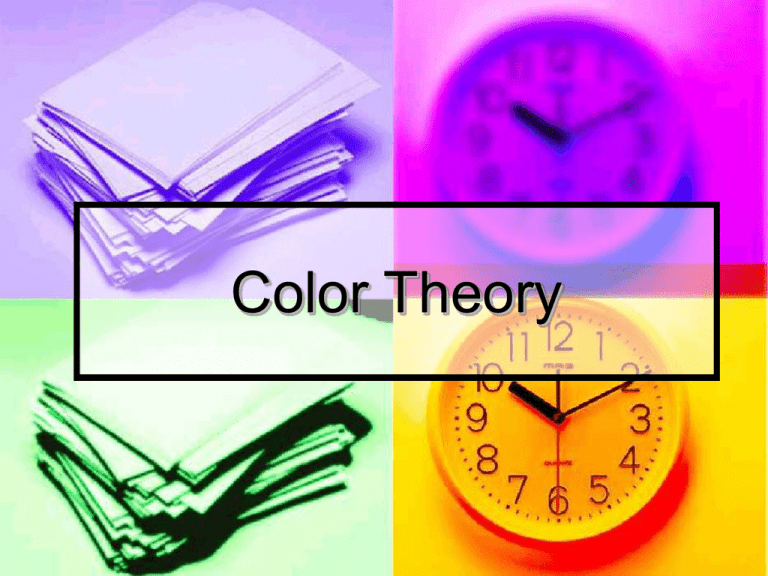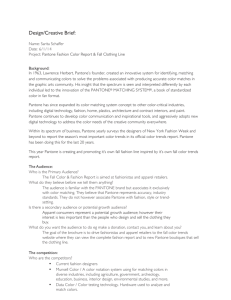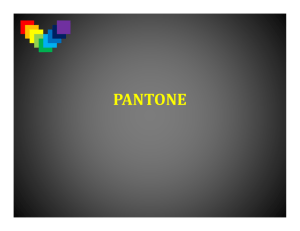Bettys TLC Dog Training
advertisement

Color Theory Why Study Color Theory? an understanding of color will help when incorporating it into your own designs. Do not base decisions on "it looks right." Application - painting - The Fauves Whereas other artists had used color as the description of an object, the Fauves let color become the subject of their painting. A painting in the "Fauvist Manner" was one that related color shapes; rather than unifying a design with line, compositions sought an expressiveness within the relationships of the whole. Communication What is red? Candy apple red, blood red, catsup red, rose red... to try and communicate a specific hue is difficult without some sort of coding system. Early in the 1900's, Albert Munsell, a professor at an art school in Boston developed a color system Munsell's system has been reworked for today's use with the Pantone color system, TRUEMATCH, CIE systems and others. Color Systems today's use with the Pantone color system, TRUEMATCH, CIE systems and others. HTML Red Pantone® Red Pantone® Warm Red TRUEMATCH® 6-a Chroma, Saturation, Intensity. These terms are all interrelated and overlap in definition. Chroma: How a hue relates to gray Saturation: The degree of purity of a hue. Intensity: The brightness or dullness of a hue. One may lower the intensity by adding white or black. Shade and Tint Shade: A hue produced by the addition of black. Tint: A hue produced by the addition of white Color Methods When painting, an artist has a variety of paints to choose from, and mixed colors are achieved through the subtractive color method. When a designer is utilizing the computer to generate digital media, colors are achieved with the additive color method. Subtractive Color Subtractive Color. When we mix colors using paint, or through the printing process, we are using the subtractive color method. Subtractive color mixing means that one begins with white and ends with black; as one adds color, the result gets darker and tends to black. The CMYK color system is the color system used for printing. Those colors used in painting—an example of the subtractive color method. Additive Color Additive Color. If we are working on a computer, the colors we see on the screen are created with light using the additive color method. Additive color mixing begins with black and ends with white; as more color is added, the result is lighter and tends to white. RGB The RGB colors are light primaries and colors are created with light. Percentages of red, green, & blue light are used to generate color on a computer screen. CMYK Reproducing color can be problematic with regard to printed digital media, because what we see is not what we get. Although a monitor may be able to display 'true color' (16,000,000 colors), millions of these colors are outside of the spectrum available to printers. Working within the CMYK color system, or choosing colors from Pantone© palettes insures proper color rendering. Photoshop RGB and CMYK Color Sliders Spectrum Success We determine whether or not we are successful by critically assessing the visual balance and harmony of the final composition—balance and harmony are achieved by the visual contrast that exists between color combinations. Planning a successful color combination begins with the investigation, and understanding, of color relationships. Color Relationships There should be thought and reason behind every design decision from color to layout to choice of type and art. Using a color wheel and a template, the relationships between colors are easy to identify. Choose a color relationship based on what you are trying to convey, whether it is feeling or information. Relationships Monochromatic Relationship Colors that are shade or tint variations of the same hue. Complementary Relationship Those colors across from each other on a color wheel. More Relationships Split-Complementary Relationship One hue plus two others equally spaced from its complement. Double-Complementary Relationship Two complementary color sets; the distance between selected complementary pairs will effect the overall contrast of the final composition. More Relationships Analogous Relationship Those colors located adjacent to each other on a color wheel. Triad Relationship Three hues equally positioned on a color wheel. Contrast The contrast is formed by the juxtaposition of light and dark values and their relative saturation. The contrast is formed by the juxtaposition of light and dark values. This could be a complementary composition. The contrast is formed by size in relation to the visual weight of a color. Working with Systems The Visible spectrum consists of billions of colors, a monitor can display millions, a high quality printer is only capable of producing thousands, and older computer systems may be limited to 216 cross-platform colors. Pantone Matching System The accuracy of color is critical in design. Because what you see on your monitor is never what will appear on a printed sheet, designers need a standardized color key. A logo can be deep blue on the client's letterhead, bluegreenish on his business card, and light blue on his very expensive envelopes. A way to prevent this is by using a standardized color matching system, such as the PANTONE MATCHING SYSTEM. Though PANTONE is not the only color standardization system, it is the most widely used and the one that most printers understand. Aside from being able to have consistency, PANTONE Colors allow you to use colors that cannot be mixed in CMYK. For More Information… www.worqx.com www.pantone.com











